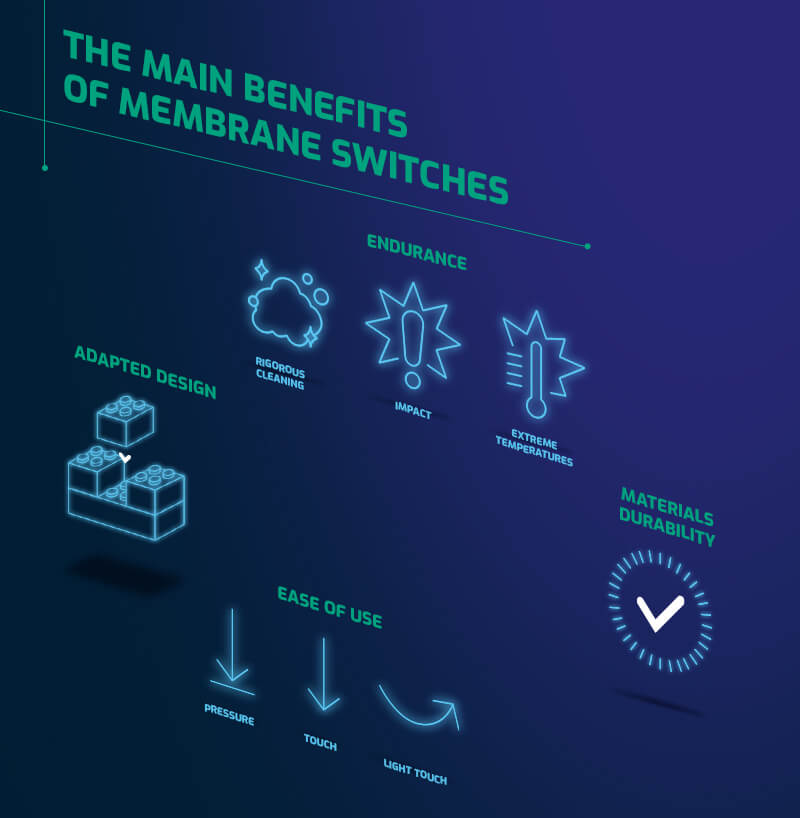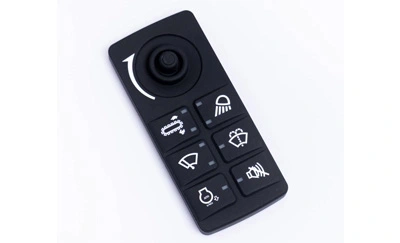The Manufacturing Process Behind Membrane Switch Over: What You Required to Know
The production procedure behind membrane layer changes combines careful layout, material option, and quality assurance. It starts with comprehending the intricacies of membrane layer switch style and proceeds via numerous phases, including material selections and printing methods. Each phase plays an important duty in making certain performance and toughness. Nonetheless, the complexities of layer building and the rigorous testing criteria might expose understandings that are not right away apparent. What lies past these foundational aspects?
Understanding Membrane Switch Layout
Membrane layer switches may show up basic at very first glimpse, their design includes detailed factors to consider that ensure functionality and durability. The layout process begins with a thorough understanding of user demands, including the interface's intended application and environmental elements. Functional designs is a crucial element, as the format needs to assist in ease of use while making sure that responsive responses satisfies individual expectations.Moreover, the layering of elements, such as visuals overlays, glue layers, and conductive traces, must be precisely crafted. membrane switch. This layered configuration not only influences the button's responsiveness yet likewise impacts its durability. Interest is offered to the securing strategies utilized to safeguard versus wetness and dirt, which could jeopardize performance. In addition, design factors to consider expand to looks, where color design and visual quality improve customer experience. Inevitably, the design of membrane changes equilibriums functionality, customer experience, and sturdiness, guaranteeing that they meet the needs of numerous applications properly
Products Utilized in Membrane Layer Change Production
When picking products for membrane button manufacturing, it is vital to contemplate both efficiency and durability. The primary products include polyester and polycarbonate films, which give adaptability and strength. These films are usually covered with sticky to assure proper bonding to substratums. Conductive inks, normally made up of silver or carbon, are vital for developing electric links within the button, permitting trustworthy operation.Additionally, a protective layer, such as a hard layer, is regularly related to enhance scratch resistance and durability. The choice of backing product, such as acrylic or foam, can significantly influence the button's tactile feel and general individual experience. Numerous environmental aspects, consisting of temperature and moisture, need to guide material selection to guarantee peak performance in certain applications. Eventually, the ideal mix of products adds to the membrane layer switch's functionality and lifespan, making educated choices vital for manufacturers.
The Printing Refine: Creating Video and Text
The printing process in membrane switch production plays a significant function in generating high-grade graphics and message. Numerous visuals style strategies are utilized to assure aesthetic appeal and performance, while cautious ink choice methods are essential for durability and performance. Understanding these aspects is fundamental for achieving best cause membrane layer button layout.
Graphic Design Techniques
Graphic design strategies play an essential function in the printing process of membrane layer buttons, as they specify how graphics and text will ultimately show up on the end product. Efficient graphic design involves the critical use layouts, fonts, and colors to enhance readability and visual appeal. Designers typically utilize vector graphics for scalability, guaranteeing that pictures stay sharp at various sizes. In addition, interest to comparison and placement is important, as it influences customer interaction and aesthetic high quality. The unification of branding components, such as logos, need to be taken care of with treatment to maintain brand name stability. Generally, thoughtful visuals layout techniques contribute significantly to the functionality and appearance of membrane buttons, impacting individual experience and product performance.
Ink Option Methods
Picking the appropriate ink is vital for achieving the wanted visual top quality and resilience in membrane layer switch manufacturing. Various ink types are utilized, including solvent-based, water-based, and UV-curable inks. Each type supplies distinct characteristics, such as flexibility, attachment, and resistance to environmental factors. Solvent-based inks are commonly favored for their toughness and vivid colors, while water-based inks are more eco pleasant but may have limitations in attachment. UV-curable inks give quick curing and robust efficiency. Additionally, color matching methods assure that the picked inks straighten with design specifications. Inevitably, the option of ink should think about elements such as application method, substrate compatibility, and end-use requirements to attain remarkable outcomes in membrane switch graphics and text.
Layer Building And Construction and Assembly

Material Choice Process
A cautious selection of products is vital in the manufacturing process of membrane buttons, as it directly influences functionality and longevity. The main products used consist of polyester, polycarbonate, and various conductive inks. Polyester is commonly preferred for its superb resistance to chemicals and abrasion, making it ideal for harsh environments. Polycarbonate, on the various other hand, gives exceptional clearness and influence resistance, which is valuable for applications requiring presence and robustness. Conductive inks, typically made up of silver or carbon, are crucial for developing trustworthy electrical pathways. In addition, the option of sticky materials affects the overall integrity of the switch - membrane switch. Reviewing aspects such as environmental exposure, tactile responses, and aesthetic requirements overviews suppliers in selecting the ideal materials for their particular applications
Layer Bond Methods
Sticking layers in membrane layer button construction is an important procedure that ensures performance and longevity. Different bond methods check these guys out are utilized to protect excellent bonding between layers, which normally consist of using adhesives, warmth, and pressure. Pressure-sensitive adhesives (PSAs) are generally utilized for their convenience of application and prompt bonding capacities. Additionally, thermal bonding methods can be used, where heat is utilized to turn on glue buildings, securing a solid bond. The selection of adhesion approach greatly relies on the materials involved and the details application demands of the membrane button. Correct placement and consistent application of adhesives are important to protect against problems, protecting the switch runs effectively throughout its desired life-span.
Quality Assurance Steps
Ensuring quality assurance throughout the layer building and construction and setting up of membrane switches is essential for keeping efficiency and dependability. This procedure generally entails numerous crucial procedures, consisting of complete assessments at each stage of manufacturing. Producers make use of advanced testing techniques, such as peel examinations and bond assessments, to confirm the integrity of layer bonds. Additionally, visual assessments are conducted to recognize any type of defects in printing or material inconsistencies. Environmental problems, such as temperature level and moisture, are thoroughly kept track of to ensure optimal healing and attachment. Regular calibration of devices helps maintain accurate production requirements. By weblink implementing these quality assurance steps, producers can considerably decrease the risk of product failing, ensuring that the last membrane layer changes fulfill the called for requirements and client assumptions.
Evaluating and Quality Assurance Steps

Advancements in Membrane Layer Switch Over Technology
As advancements in technology remain to evolve, membrane switches are benefiting from cutting-edge developments that improve their functionality and customer experience. One noteworthy innovation is the combination of capacitive touch technology, which permits even more responsive and intuitive user interfaces. This change not only improves aesthetic appeals yet additionally reduces mechanical damage, expanding the life-span of the switches.Additionally, advancements in graphic overlay materials have caused improved durability and resistance to ecological aspects such as dampness and UV light. These materials now offer improved clarity and brightness, more elevating the visual appeal.Furthermore, the incorporation of clever innovation is changing membrane layer switches right into interactive control panels, allowing connection with IoT devices. This connectivity cultivates a smooth user experience, paving the way for applications in different industries, from health care to customer electronic devices. Jointly, these advancements placement Our site membrane layer switches as important elements in modern-day device layout.
Often Asked Questions
How Long Does the Membrane Switch Production Refine Take?
The period of the membrane layer button production procedure can vary considerably. Factors such as complexity, products made use of, and manufacturing quantity impact timelines, with normal production ranging from a couple of days to a number of weeks for conclusion.
What Are the Typical Applications for Membrane Buttons?
Membrane switches are typically utilized in numerous markets, including automotive controls, family home appliances, medical tools, and consumer electronic devices (membrane switch). Their adaptability and durability make them optimal for applications needing straightforward interfaces and reputable efficiency in diverse settings
Can Membrane Changes Be Personalized for Certain Demands?

What Is the Life expectancy of a Regular Membrane Layer Change?
The life-span of a normal membrane layer button differs, but usually, it varies from 1 to 5 million cycles. Variables such as use, setting, and worldly quality significantly influence resilience and total efficiency over time.

Are Membrane Changes Eco-friendly?
The environmental kindness of membrane changes differs. Some products made use of might not be recyclable, while others can be environment-friendly. The overall impact depends upon producing techniques and materials, necessitating cautious factor to consider during choice and disposal. The manufacturing procedure behind membrane layer changes combines careful design, product selection, and top quality control. It begins with understanding the ins and outs of membrane button style and progresses via various phases, including material choices and printing techniques. When choosing products for membrane button production, it is necessary to ponder both performance and durability. A mindful choice of materials is vital in the production process of membrane layer buttons, as it directly influences capability and durability. The choice of attachment technique mostly depends on the materials involved and the particular application requirements of the membrane layer button.